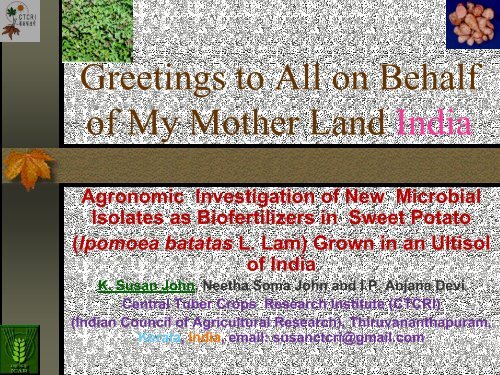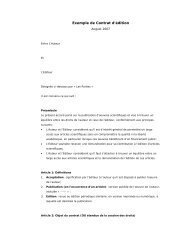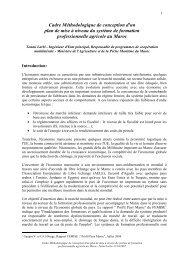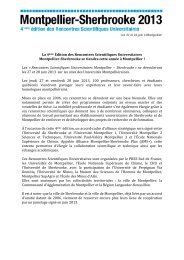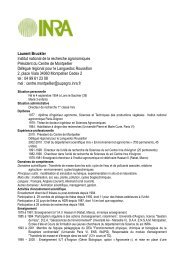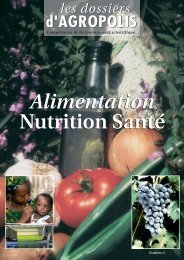Agronomic Investigation of New Microbial Isolates as Bio fertilizers ...
Agronomic Investigation of New Microbial Isolates as Bio fertilizers ...
Agronomic Investigation of New Microbial Isolates as Bio fertilizers ...
You also want an ePaper? Increase the reach of your titles
YUMPU automatically turns print PDFs into web optimized ePapers that Google loves.
Greetings to All on Behalf<br />
<strong>of</strong> My Mother Land India<br />
<strong>Agronomic</strong> <strong>Investigation</strong> <strong>of</strong> <strong>New</strong> <strong>Microbial</strong><br />
<strong>Isolates</strong> <strong>as</strong> Bi<strong>of</strong>ertilizers in Sweet Potato<br />
(Ipomoea batat<strong>as</strong> L. Lam) Grown in an Ultisol<br />
<strong>of</strong> India<br />
K. Susan John, Neetha Soma John and I.P. Anjana Devi<br />
Central Tuber Crops Research Institute (CTCRI)<br />
(Indian Council <strong>of</strong> Agricultural Research), Thiruvananthapuram,<br />
Kerala, India, email: susanctcri@gmail.com
ALL INDIA NET WORK ON TUBER CROPS<br />
Started during<br />
1968<br />
4<br />
14<br />
3<br />
15<br />
16<br />
1<br />
2<br />
5<br />
6 7<br />
8<br />
17<br />
9<br />
11<br />
10<br />
12<br />
13<br />
1. TNAU, Coimbatore<br />
2. ANGRAU, Hyderabad<br />
3. KKV, Dapoli<br />
4. NAU, Nav<strong>as</strong>ari<br />
5. IGKV, Jagadalpur<br />
6. NDUA&T, Faizabad<br />
7. RAU, Dholi<br />
8. BAU, Ranchi<br />
9. BCKV, Kalyani<br />
10. AAU, Jorhat<br />
11. ICAR RC NEH, Shillong<br />
12. CARI, Port Blair<br />
13. CAU, Imphal<br />
14. MPUAT, Udaipur<br />
15. UAS, Dharwad<br />
16. CTCRI, HQ<br />
17. CTCRI, RC
The sole institute in the world exclusively dedicated to research h on<br />
Tropical Tuber Crops<br />
Head quarters Thiruvananthapuram,<br />
Kerala<br />
Regional centre Bhubaneswar,<br />
Orissa<br />
Research carried out under 5 Divisions<br />
Division <strong>of</strong> Crop Improvement Division <strong>of</strong> Crop Production<br />
Division <strong>of</strong> Crop Protection<br />
Section <strong>of</strong> Social Sciences<br />
Division <strong>of</strong> Crop Utilization
C<strong>as</strong>sava( Manihot esculenta Crantz)<br />
Sweet potato( Ipomoea batat<strong>as</strong> Lam L.)<br />
Elephant foot yam(Amorphophallus<br />
paeonifolius)<br />
Yams(Dioscorea sp.)
Taro(Coloc<strong>as</strong>ia sp.)<br />
(Coleus rotundifolius)<br />
Arrowroot(Maranta<br />
arundinaceae)<br />
Tannia (Xanthosoma sagittifolium)
MANDATE<br />
‣ To undertake b<strong>as</strong>ic, strategic and applied research for<br />
generating technologies to enhance productivity and<br />
utilisation potential <strong>of</strong> tuber crops viz., c<strong>as</strong>sava, sweet<br />
potato, yams, aroids (EFY, taro, tannia), coleus and yam<br />
bean (other than potato)<br />
‣ To act <strong>as</strong> a national repository <strong>of</strong> scientific information on<br />
tuber crops<br />
‣ To coordinate network research with State Agricultural<br />
Universities for generating location specific technologies<br />
‣ To act <strong>as</strong> a centre <strong>of</strong> human resources development for<br />
various clientele systems involved in tuber crops research<br />
and development<br />
‣ To undertake transfer <strong>of</strong> tuber crops technologies through<br />
consultancy, outreach programmes and linkage with<br />
developmental agencies
"Greater emph<strong>as</strong>is on tuberous crops such <strong>as</strong> potato,<br />
tapioca and sweet potato to make them available at<br />
cheaper rates"<br />
Dr. A P J Abdul Kalam<br />
(Former president <strong>of</strong> India)
ALL INDIA NET WORK ON TUBER CROPS<br />
Started during<br />
1968<br />
4<br />
14<br />
3<br />
15<br />
16<br />
1<br />
2<br />
5<br />
6 7<br />
8<br />
17<br />
9<br />
11<br />
10<br />
12<br />
13<br />
1. TNAU, Coimbatore<br />
2. ANGRAU, Hyderabad<br />
3. KKV, Dapoli<br />
4. NAU, Nav<strong>as</strong>ari<br />
5. IGKV, Jagadalpur<br />
6. NDUA&T, Faizabad<br />
7. RAU, Dholi<br />
8. BAU, Ranchi<br />
9. BCKV, Kalyani<br />
10. AAU, Jorhat<br />
11. ICAR RC NEH, Shillong<br />
12. CARI, Port Blair<br />
13. CAU, Imphal<br />
14. MPUAT, Udaipur<br />
15. UAS, Dharwad<br />
16. CTCRI, HQ<br />
17. CTCRI, RC
Introduction<br />
Sweet potato is grown in the tropics and warm temperate regions <strong>of</strong> the<br />
world<br />
Globally, grown in developing countries in an area <strong>of</strong> 9 mha having a<br />
production <strong>of</strong> 124 mt with a productivity <strong>of</strong> 13.7 t ha -1 (FAOSTAT, 2006)<br />
China ranks first in area (4.7 m ha) and production (70 m t) with a<br />
productivity <strong>of</strong> 14 t ha -1 (FAOSTAT, 2001)<br />
Third most important tuber crop in India after potato and c<strong>as</strong>sava<br />
India occupies 12 th , 8 th and 5 th rank globally in terms <strong>of</strong> area, production and<br />
productivity with an area <strong>of</strong> 0.14 mha, production 1.21 mt and productivity<br />
8.87 t ha -1 (CMIE,2006)<br />
In India, grown in Orissa, West Bengal, Uttar Pradesh, Bihar and Jharkand<br />
accounting 77% <strong>of</strong> area and 82% <strong>of</strong> production<br />
In Kerala, it is grown in an area <strong>of</strong> 505 ha with a production <strong>of</strong> 6405 t and<br />
productivity is 12.68 t ha -1 ( Farm guide,2009)
SWEET POTATO GROWING BELT OF INDIA
Facts about sweet potato<br />
No. <strong>of</strong> varieties rele<strong>as</strong>ed from CTCRI-27<br />
Propagation through vine cuttings<br />
Method <strong>of</strong> planting-Mounds, ridges, furrows and flat beds<br />
Nutrient management-NPK@50:25:50 kg ha -1 + FYM @5 t ha -1<br />
<br />
<br />
<br />
<br />
<br />
Major pest- Sweet potato weevil- M<strong>as</strong>s trapping <strong>of</strong> adult weevils using sex<br />
pheromone<br />
Post harvest utilization- Roots and leaves <strong>as</strong> human food and roots and<br />
vines <strong>as</strong> animal feed<br />
Processed into industrial starch, alcohol, noodles and other products viz.,<br />
jam, jelly, pickles, squ<strong>as</strong>hes etc.,<br />
H<strong>as</strong> an average protein content comparable to that <strong>of</strong> rice (1.3-10.0% on<br />
DWB) (Purcell et al., 1972)<br />
It is also a good source <strong>of</strong> Ca, <strong>as</strong>corbic acid, and ß- carotene.
Some sweet potato varieties rele<strong>as</strong>ed from CTCRI<br />
Sree Arun<br />
Orange- fleshed sweet potato<br />
Orange fleshed sweet potato contains β carotene and anthocyanin which are cheap<br />
source <strong>of</strong> vitamin A and antioxidants<br />
Orange fleshed sweet potato can combat vitamin A deficiency in developing<br />
countries ( Harvest plus Programme)<br />
ST-14<br />
Sree Kanaka<br />
β carotene 10.50 mg/100g<br />
β carotene 8 mg/100g
Significance <strong>of</strong> the present study<br />
N fixers, P solubilizers and K mobilizers are the most beneficial soil<br />
microorganisms for use <strong>as</strong> bi<strong>of</strong>ertilizers in agriculture<br />
The main objective <strong>of</strong> using bi<strong>of</strong>ertilizers is to reduce fertilizer<br />
quantity there by reduce the cost <strong>of</strong> production and an eco-friendly<br />
practice<br />
Exploitation <strong>of</strong> agro-biodiversity for identifying useful<br />
microorganisms for nutrient management <strong>as</strong> well <strong>as</strong> biocontrol is a<br />
thrust area in the present day agriculture to substitute for chemical<br />
<strong>fertilizers</strong> and pesticides and to maintain soil health<br />
Objective<br />
To screen, isolate, identify and characterize potent N fixers and P<br />
solubilizers from the biodiversity hot spots <strong>of</strong> Western ghats <strong>of</strong><br />
Kerala and to agronomically evaluate their efficacy <strong>as</strong> a substitute to<br />
chemical <strong>fertilizers</strong> in sweet potato to enhance growth and yield
Methodology<br />
a. Microbiological work<br />
Survey and collection <strong>of</strong> soil samples - High biodiversity hot spot<br />
are<strong>as</strong> <strong>of</strong> South India<br />
<strong>Microbial</strong> ( bacteria, fungi & actinomycetes) enumeration - Serial<br />
dilution and plate counting<br />
From the bacterial population, screening for P solubilizers -<br />
Pikovskaya’s agar media<br />
N fixers - Jensen’s nitrogen free solid medium<br />
P solubilizing capacity- Vanado molybdo phosphoric yellow colour<br />
method<br />
N fixing capacity - Kjeldhal method<br />
b. Preparation <strong>of</strong> bi<strong>of</strong>ertilizer<br />
<br />
<br />
M<strong>as</strong>s multiplication <strong>of</strong> potent isolates<br />
100 ml <strong>of</strong> the broth containing the isolates mixed with sand and<br />
charred rice husk (1:4) <strong>as</strong>eptically
Sampling locations –AGASTHYAMALAI RANGES<br />
Kulathupuzha RF<br />
Thenmala RF<br />
Peppara RF<br />
Aryan Kau RF<br />
Kollam<br />
Kottur RF<br />
Kottur Extension<br />
Trivandrum<br />
Palode RF<br />
Kalakkad RF<br />
Lower Kothayar RF<br />
Kothayar RF<br />
Pechiparai RF<br />
Neyyar RF<br />
Ponmudi RF<br />
Nagarcoil
c. Molecular characterization <strong>of</strong> the bi<strong>of</strong>ertilizer microbes<br />
Isolation <strong>of</strong> the genomic DNA (Sambrook et al. 1989)<br />
<br />
<br />
<br />
<br />
<br />
Amplification <strong>of</strong> 16s rDNA - Forward 8F primer<br />
5'AGAGTTTGATCCTGGCTCAG3' and reverse 1492R primer<br />
5'CGGCTACCTTGTTACGACTT3’ (Babu et al. 2004)<br />
Agarose Gel Electrophoresis (AGE) with 100 bp marker (NE<br />
<strong>Bio</strong>labs)<br />
The band cut, eluted and purified using the QIA quick gel<br />
extraction kit, QIAGEN<br />
Sequencing <strong>of</strong> the eluted product - Genei, Bangalore<br />
Sequence analysis - National Centre <strong>of</strong> <strong>Bio</strong>technology<br />
Information (NCBI) datab<strong>as</strong>e -B<strong>as</strong>ic Local Alignment Search Tool<br />
(BLAST)
• No. <strong>of</strong> treatments - 9 Replication - 3 Design – CRD<br />
Initial status<br />
• Organic carbon-1.36%, Available P-184 kg ha -1 , Exchangeable K-159 kg ha -1<br />
• Quantity <strong>of</strong> N- 78%, Available P-0, Exchangeable K-83% <strong>of</strong> POP rate<br />
(Aiyer,Nair,1985)<br />
Treatment details <strong>of</strong> the pot experiment<br />
Treat<br />
d. <strong>Agronomic</strong> investigation <strong>of</strong> the bio fertilizer efficacy<br />
1. P solubilizer<br />
a. Controlled condition experiment in pots<br />
Treatments<br />
T1 Soil test b<strong>as</strong>ed fertilizer (STBF) recommendation (NPK@ 39:0:41.5 kg ha ‐1 )<br />
T2 Package <strong>of</strong> Practice (POP) recommendation for sweet potato (NPK @ 50:25:50 kg ha ‐1 )<br />
T3 Phosphate solubilizing bacteria alone<br />
T4 STBF + bi<strong>of</strong>ertilizer (PSB) (NPK@ 39:0:41.5 kg ha ‐1 )<br />
T5 NK + ¼P + bi<strong>of</strong>ertilizer (NK @ 50:50 kgha ‐1 + P@ ¼<strong>of</strong> 25 kgha ‐1 )<br />
T6 NK + ½P + bi<strong>of</strong>ertilizer (NK @ 50:50 kgha ‐1 +P@ ½<strong>of</strong> 25 kgha ‐1 )<br />
T7 NK + ¾P +bi<strong>of</strong>ertilizers (NK@ 50:50 kgha ‐1 + P@ ¾<strong>of</strong> 25 kgha ‐1 )<br />
T8 NK @ 50:50 kgha ‐1 + bi<strong>of</strong>ertilizer<br />
T9 Absolute control
A View <strong>of</strong> the Pot Experiment
. Field experiment<br />
Design-RBD Treatments -12 Replication- 2 No. <strong>of</strong> se<strong>as</strong>ons- 2<br />
Treatment details<br />
T1-STBF T2 - POP T3 - PSB -1 T4 - PSB-2<br />
T5 - POP+PSB-1 T6 - POP+PSB-2 T7- 25 %P+ PSB-1<br />
T8- 25 %P+ PSB-2 T9 - 50 % P + PSB-1 T10 - 50% P + PSB-2<br />
T11 - 75% P+PSB-1 T12 - 75% P+PSB-2<br />
N & K @50:50 kg ha -1
A View <strong>of</strong> the Field Experiment
d. <strong>Agronomic</strong> investigation <strong>of</strong> the bi<strong>of</strong>ertilizer efficacy<br />
1. N fixer<br />
a. Controlled condition experiments in pots<br />
• No. <strong>of</strong> treatments - 8 Replication - 3 Design - CRD<br />
Initial status<br />
• Organic carbon- 0.26%, Av. P- 216.16 kg ha -1 , Exch. K- 303.52 kg ha -1<br />
• Quantity <strong>of</strong> N-117%, P- 0, K- 48% <strong>of</strong> POP rate ( Aiyer and Nair,1985)<br />
Treat. No.<br />
Treatments<br />
T1 Soil test b<strong>as</strong>ed ferlilizer (STBF) recommendation (NPK @ 58.5:0:24 kg ha -1 )<br />
T2 POP recommendation for sweet potato (NPK@ 50:25:50 kg ha -1 )<br />
T3 N fixer alone<br />
T4 N fixer + STBF (NPK@58.5:0:24 kg ha -1 )<br />
T5 N fixer + N(3/4 <strong>of</strong> STBF), P, K (STBF) i.e. (NPK @44:0:24 kg ha -1 )<br />
T6 N fixer + N(1/2 <strong>of</strong> STBF), P, K(STBF) i.e. (NPK @29.25:0:24 kg ha -1 )<br />
T7 N fixer + N(1/4 <strong>of</strong> STBF), P, K(STBF) i.e. (NPK @14.6:0:24 kg ha -1 )<br />
T8 Absolute control
Results<br />
No. <strong>of</strong> microbes isolated- 505<br />
No. <strong>of</strong> bacteria - 341<br />
No. <strong>of</strong> P solubilizers - 169<br />
No. <strong>of</strong> N fixers - 194<br />
<br />
P solubilization efficacy <strong>of</strong> the 2 potent isolates<br />
PSB-1- 150 µg g -1 - Enterobacter sp.<br />
<br />
PSB-2- 112.5 µg g -1 - Pantoea agglomerans<br />
N fixing capacity <strong>of</strong> the N fixer bacteria – 4%<br />
<br />
- Alcaligenes feacalis
Influence <strong>of</strong> P solubilizers on tuber yield <strong>of</strong> sweet potato (pot<br />
trial)
Zonation <strong>of</strong> P solubilizers in<br />
Pikovskay<strong>as</strong> agar medium<br />
16s rDNA amplified product
A View <strong>of</strong> the Crop Harvest<br />
( P solubilizer field experiment)
Treatment<br />
Effect <strong>of</strong> P solubilizers on growth and yield <strong>of</strong> sweet potato<br />
( Field experiment) (Mean <strong>of</strong> 2 se<strong>as</strong>ons)<br />
Tuber<br />
yield<br />
( t ha -1 )<br />
Vine<br />
yield<br />
(t ha -1 )<br />
Root:<br />
shoot<br />
ratio<br />
Harvest<br />
index<br />
Soil P<br />
(kg ha -1 )<br />
Tuber<br />
P (%)<br />
Vine<br />
P<br />
(%)<br />
P<br />
solublize<br />
rs<br />
( x 10 3<br />
cfu g -1<br />
soil)<br />
STBF 14.34 15.42 1.57 0.610 32.09 0.234 0.547 256<br />
POP 17.59 17.13 2.01 0.665 17.67 0.264 0.553 251<br />
PSB -1 10.71 7.50 1.96 0.630 12.15 0.262 0.484 220<br />
PSB-2 12.30 16.00 1.47 0.595 14.21 0.278 0.382 210<br />
POP+PSB-1 24.92 26.25 1.48 0.595 18.22 0.428 0.551 231<br />
POP+PSB-2 9.46 14.67 1.77 0.635 9.76 0.234 0.605 175<br />
25 %P+ PSB-1 19.88 28.08 0.95 0.480 20.09 0.219 0.484 119<br />
25 %P+ PSB-2 16.46 7.52 3.47 0.775 8.68 0.334 0.531 194<br />
50 % P + PSB-1 16.42 20.38 1.42 0.585 15.72 0.253 0.568 215<br />
50% P + PSB-2 16.00 20.54 1.60 0.610 30.57 0.352 0.711 164<br />
75% P+PSB-1 14.29 14.38 1.49 0.595 27.11 0.184 0.395 155<br />
75% P+PSB-2 9.75 11.17 1.01 0.495 11.82 0.267 0.309 188<br />
CD 7.097 3.339 1.016 NS 13.06 NS NS NS
Molecular characterization <strong>of</strong> N fixer
Influence <strong>of</strong> N fixer on sweet potato growth<br />
Figure 1 Influence <strong>of</strong> N fixing bacteria on growth characters <strong>of</strong> sweet potato<br />
200<br />
180<br />
160<br />
Growth characters<br />
140<br />
120<br />
100<br />
80<br />
60<br />
40<br />
20<br />
0<br />
T1 T2 T3 T4 T5 T6 T7 T8<br />
Treatments<br />
Vine length(cm) Leaf number Leaf length(cm) Leaf breadth(cm)
Effect <strong>of</strong> N fixers on tuber yield <strong>of</strong> sweet potato
Conclusions<br />
For sweet potato, among the two P solubilizers, Enterobacter sp. w<strong>as</strong> more<br />
effective<br />
By applying the P solubilizers, P dose can be reduced to 75% <strong>of</strong> POP<br />
By applying N fixer, N dose can be reduced to 25% <strong>of</strong> POP<br />
Explored the beneficial effect <strong>of</strong> new microbial isolates <strong>of</strong> N fixers and P<br />
solubilizers <strong>as</strong> a substitute to chemical <strong>fertilizers</strong><br />
Reducing cost <strong>of</strong> production, improving P status <strong>of</strong> the soil<br />
Future Thrust are<strong>as</strong><br />
Formulation <strong>of</strong> microbial consortium containing bio fertilizer cum bio<br />
control agents<br />
<strong>Agronomic</strong> investigation <strong>of</strong> the bio consortium for nutrient <strong>as</strong> well <strong>as</strong><br />
dise<strong>as</strong>e management for tropical tuber crops<br />
Popularization and large scale production <strong>of</strong> the bio consortium <strong>as</strong> a<br />
component <strong>of</strong> INM strategy for major crops
Acknowledgements<br />
This paper forms a part <strong>of</strong> ICAR net work project on<br />
‘ AMAAS ( Application <strong>of</strong> Microorganisms in Agriculture and<br />
Allied Sectos’)<br />
Funding from Indian Council <strong>of</strong> Agricultural Research<br />
NBAIM ( National Beurea <strong>of</strong> Agriculturally Important<br />
Microorganisms) for the national level coordination <strong>of</strong> the<br />
project<br />
Director, CTCRI, DG & DDG, ICAR for granting permission<br />
ESA for providing an opportunity for oral presentation and<br />
for free registration and accommodation for attending the<br />
congress<br />
Department <strong>of</strong> <strong>Bio</strong>technology, Govt. <strong>of</strong> India for<br />
international travel grant support
Thank you and Welcome to<br />
God’s s Own Country


